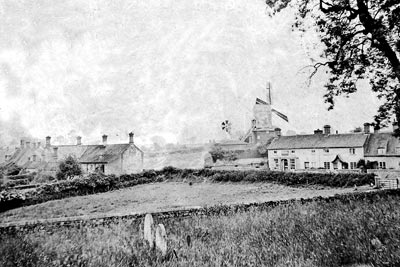
|
Swanton Morley
postmill |
 |
|
c.1890
|
|
Swanton
Morley post mill had the largest roundhouse recorded at any mill in Norfolk, being 2 feet higher than the massive Holt_Heath_postmill.
The structure was 20' high to the eaves, incorporating three storeys and had a diameter
of 26' 6". The roundhouse had two 14ft piers and two doors on the ground floor. |
|
The four double shuttered sails, each with 9 bays of 3 shutters, drove one pair of French burr stones and one pair of Peak stones. The 8 bladed fantail was set onto the ladder and Joseph Canham's model depicts a porch on the gable end of the mill. |
Francis Daynes was the miller in the 1840s and was married to Elizabeth Daynes. Francis died on 3rd May 1850, having written a will on I give John Williams, his heirs, executors, administrators etc – all my messuage or dwelling house with outhouses, yard, garden, land and appurtenances to the same adjoining and belonging and also all that WINDMILL with the ROUND HOUSE, to the same belonging, standing and being on the said land with going gears, fixtures, machinery and appurtenances to the same belonging which premises are situate in Swanton Morley aforesaid and now in my own occupation. Samuel Barker, William Gunton, William Tillett, John Margerson, Samuel Leader, George Harris, Thomas Bone, James Jaevis, Absolon Bone, Henry Dawson, Elizbeth Peg, and James Doy. |
Wanted immediately. |
To Journeymen Millers |
To Journeymen Millers |
SITUATIONS VACANT |
Situations Vacant |
Situations Vacant |
Situations Vacant |
Situations Vacant |
To Millers & Bakers |
Situations Vacant |
Situations Vacant |
Situations Vacant |
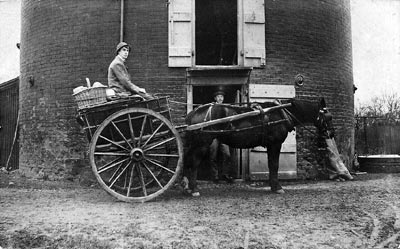 |
c.1900 |
In the village was an old wooden windmill the sails of which when we arrived were motionless: these now began to whirl round and round at a great pace for the thunder had brought up a great gale of wind. We saw the miller running up in haste from the public house where, doubtless in despair of doing any work that day, he had been indulging in some good Norfolk ale. Possibly he feared now lest his mill should ‘run on fire’ and was anxious to get the brake on, for these old wooden windmills often get burnt down by the speed at which their sails are whirled round in a storm that comes suddenly upon them. |
The Mill, SWANTON MORLEY |
SWANTON MORLEY |
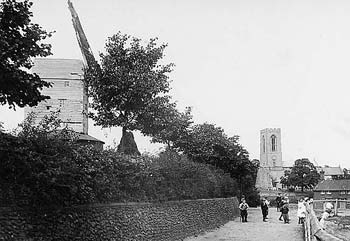 |
c.1906 |
The boy with the crutches on the left in the above photograph, was Ben Beavis who went on to run a cycle repair shop in the village. |
In 1891 a 7hp portable steam engine was being used for auxiliary power but by 1904 this had been changed to a Crossley paraffin engine that was started using a blowlamp. Both engines were used to drive a pair of stones within the roundhouse. |
William Hilton took the mill over in 1891 and remained there until his death in 1907 when William's son Ernest took over the running of the mill. Ernest was also tenant at Elsing_watermill for 9 years from around 1915 - 1924 before returning to Swanton Morley. |
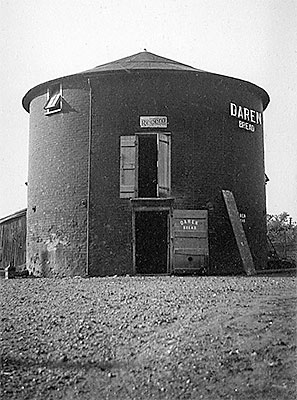 |
c.1925 |
Swanton Mill |
Talking of windmills, it is just over fifty years since the post mill at Swanton Morley was dismantled. This was a fine specimen in its day, and stood practically in the centre of the county of Norfolk, three and a-half miles from the market town of East Dereham. Standing on high ground overlooking the village street, the church and the Wensum Valley across which could be seen Belaugh Hall, this was a picturesque situation. The round house is still standing and is in a remarkably good state of preservation. It is now being used for storage. Inside this building can be seen the massive brick pillars, strengthened by iron bands, which used to support the weighty structure above, containing the sails, millstones, gear wheels, etc. Although only a lad at the time, there are many things I remember about this mill. The four sails were fixed to a long iron shaft, which weighed over a ton, through the centre of which passed an iron rod. This operated the vanes, causing them to open and close against the pressure of the wind. My father took over this mill in 1891 and it was at that time in fairly good working order. There were two pairs of stones, one pair being strictly kept for grinding wheat later to be made into flour or wholemeal bread. These stones were not used for any other purpose if it could possibly be avoided, as if they were so used the remnants of meal would have to be thoroughly cleaned out before the grinding of wheat could be resumed. The other pair were in general use for grinding barley, oats, etc. I remember the long periods which sometimes occurred when there was not sufficient wind to turn the sails, and the corn would continue to come from the neighbouring farms causing my father much uneasiness through not being able to grind. On these occasions he would anxiously wait for a breeze to spring up. I have known the sails to be merrily going round when there was practically no wind to be felt on the ground; although these conditions were occasionally in reverse, when there was no activity aloft. More than once I have known it to happen that after a long spell of enforced idleness the wind would rise in the evening and would continue to blow through the night, and then it meant working through the hours of darkness, illumination being by candles and a hurricane lantern. On certain nights when this occurred I have been allowed, as a special treat, to be in the mill most of the night with my father instead of going to bed. I used to consider this great fun, but I do not think he shared that view. However, the work had to be done while the going was good and such an opportunity was not to be lost. My father’s observance of the Sabbath was such that he would not grind on Sunday, however hard he was pressed. This reminds me of a certain Sunday afternoon, I think it was about 1896, when there was a tremendous gale. It was his custom to attend the service at the Methodist Chapel, and during the progress of the sermon someone came along and told him that his mill was “going round.” He knew, of course, that the brake was on and that serious damage would soon occur through friction. Accordingly, he had to hurry home and release the brake allowing the sails to revolve with as little wind pressure on the vanes as possible. So far as I remember however, no serious damage resulted, although there were plenty of casualties to other buildings in the locality. When the direction of the wind changed suddenly, the spin-wheel at the back would operate automatically and change the whole structure round, so the sails were always facing into the wind. If we were working inside the mill for several hours during the night, this might happen while we were quite unaware of it, so that when we descended the long steps outside, they would be in a different position. This mill, along with many others, became obsolete about the beginning of the present century. I was not living at home when it was actually demolished, therefore I did not see the ponderous sails and shafting lowered to the ground, but I know of at least man who helped take it down. Anyway, it is a good thing it was not allowed to rot away gradually as were so many of these interesting old relics of the past. Bertie William Hilton, son of William Hilton Eastern Daily Press - c.1952 |
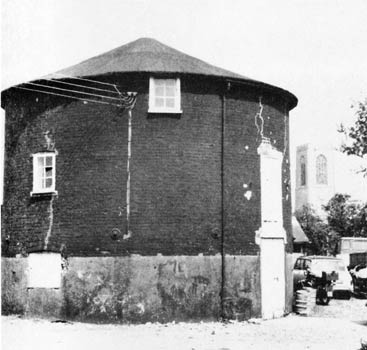 |
20th May 1978 |
And I devise All that messuage or dwellinghouse with the building formerly a Windmill with the outhouses buildings yard garden land & premises adjoining or near or belonging thereto or held therewith now in the occupation of Wm. Hilton. |
Pencilled notes in the roundhouse: |
| WILL BUSHELL Jan 1785 JAMES BUCKENHAM Swanton Mill 1873 (x 2) WILLIAM EGLEN ANSY 1873 WILLIAM EGLEN ANSY 1876 W. WILLIAMS pony killed Feb. 12 1876 Saturday evening A very high wind March 24 1895 (by south wind ?) sails they fly off the old mill July 18th '04 Band of Hope went to Yarmouth Very hot day |
In 1906 the body of the mill was demolished by the local carpenter Joseph Canham assisted by Albert S. (Sparrow) Rump, who went on to become sexton. Joseph Canham later made a large scale model of the mill. |
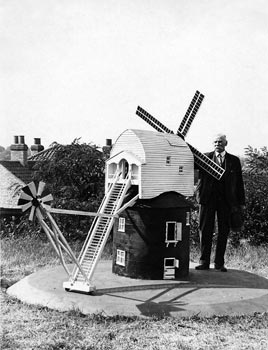 |
Joseph Canham and his model c.1950 |
Mr. Joseph Canham, of Swanton Morley, who is nearly 80 years of age, has built a model of a windmill that was dismantled at Swanton Morley before the war. Everything in the model has been hand-made, even the hinges on the doors, by Mr. Canham, who helped in dismantling the old mill. The model has been fixed in a cement plot in the grounds of Mr. H. W. Fox, of Quebec Road, Dereham. |
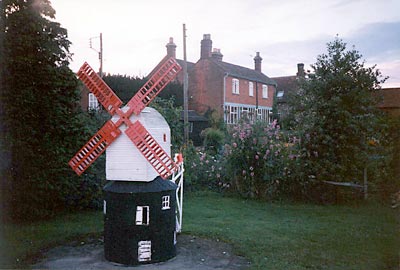 |
Joseph Canham's model in 1988 |
The model was moved to the garden of “Holmlea” in Swanton at sometime. More lately “Holmlea” was occupied by Emma’s grand children Ray and Edna Hilton. Ray looked after the model for many years and I took the above photo of it in 1988 but it fell into disrepair after Ray’s death in 1995. |
In August 2007, Alistair Milne of the Mill House reported that the model was indeed back with Joseph Canham's son Clive in the village. |
Swanton Mill |
Talking of Windmills, it is just over 50 years since the post mill at Swanton Morley was dismantled. This was a fine specimen in its day and stood practically in the centre of the County of Norfolk, three and a half miles from the market town of East Dereham. Standing on high ground overlooking the village street, the church and the Wensum Valley across which could be seen Bylaugh Hall, this was a picturesque situation. The roundhouse is still standing and is in a remarkably good state of preservation. It is now being used for storage. Inside this building can be seen the massive brick pillars strengthened by iron bands which used to support the weighty structure above, containing the sails, millstones, gear wheels etc. Only a lad at the time, there are many things I remember about this mill. Then four sails were fixed to a long iron shaft, which weighed over a tonne, through the centre of which passed an iron rod. This operated the vanes causing them to open and close against the pressure of the wind. My father took over this mill in 1891 and it was at that time in fairly good working order. There were two pairs of stones, one pair being kept strictly for grinding wheat later made into flour or wholemeal bread. These stones were not used for any other purpose if it could possibly be avoided, as if they were so used the remnants of meal would have to be thoroughly cleaned out before the grinding of wheat could be resumed. The other pair were in general use for grinding barley. oats etc. I remember the long periods which sometimes occurred when there was not sufficient wind to turn the sails and the corn would continue to come in from the neighbouring farms, causing my father much uneasiness through not being able to grind. On these occasions he would anxiously wait for a breeze to spring up. I have known the sails to be merrily going round when there was practically no wind to be felt on the ground; also these conditions were occasionally in reverse when there was no activity aloft. More than once I have known it to happen that after a long spell of enforced idleness, the wind would rise in the evening and continue to blow through the night and then it meant working through the hours of darkness, illumination being by candles and hurricane lantern. On certain nights when this occurred, I have been allowed, asa special treat, to be in the mill most of the night with my father instead of going to bed. I used to consider this great fun, but I do not think he shared the same view. However, the work had to be done while the going was good and such an opportunity was not to be lost. My father's observance of the Sabbath was such that he would not grind on Sunday, however hard he was pressed. This reminds me of a certain Sunday afternoon, I think it was about 1896, when there was a tremendous gale. It was his custom to attend the service at he Methodist Chapel and during the progress of the sermon, someone came along and told him him that his mill was 'going round'. He knew, of course, that the brake was on and that serious damage would soon occur through the friction. Accordingly he had to hurry home and release the brake, allowing the sails to revolve with as little wind pressure on the vanes as possible. So far as I remember, however, no serious damage resulted, although there were plenty of casualties to other buildings in the locality. When the direction of the wind changed suddenly, the spin-wheel at the back would operate automatically and turn the whole structure round so the sails were always facing into the wind. If we were working inside the mill for several hours during the night, this might happen while we were unaware of it so that when we descended the long steps outside, they would be in a different position. This mill, along with many others, became obsolete about the beginning of the present century. I was not living at home when it was actually demolished, therefore, I did not see the ponderous sails and shafting lowered to the ground, but I know of at least one man who helped to take it down. Anyway, it is a good thing that it was not allowed to rot away gradually as were so many of these interesting old relics of the past. Eastern Daily Press - A Norfolk Miscellany - 1951 Notes by Harry Apling: 'H. W. B.' was Bertie William Hilton, son of William Hilton , the miller 1891-1906. The gale was probably that of 24 March 1895, a disastrous day for several Norfolk windmills. The 'one man who helped to take it down' would have been Albert S. Rump, later the sexton. |
Notes by Harry Apling 1975 : |
| Mr. Raymond A. Hilton & Miss Edna Hilton, Holmlea, Town Street, Swanton Morley. 9 November 1975. Grandson & grand-daughter of William Hilton Son & daughter of Ernest E. Hilton, baker only Bertie William Hilton & Percy J. Hilton of Beatrice Ave. Dereham, other sons of William Hilton Mrs. (R. R.) Tye daughter of Ernest E. Hilton In 1904 mill had auxiliary power a Crossley paraffin engine started with a blow lamp. Body of mill taken down in 1906 by Joseph Canham, a local carpenter assisted by Albert S. Rump, to whom I spoke today. R. A. Hilton has the model of the mill made by J. Canham, at one time in the garden of H. W. Fox, 15 Quebec Road, Dereham. Body too low and narrow in proportion to its length and sails too short. Has 8-bladed fantail and gable end porch. |
In March 1928 the mill complex was sold with Ernest Hilton as tenant at the mill. The full text of the newspaper advertisement is available in the form of a downloadable_pdf_file. Ernest Hilton's mother, Emma bought the property and they remained at the mill house until 1950, when the family moved to another house in the village Holmlea, due to Ernest's ill health. |
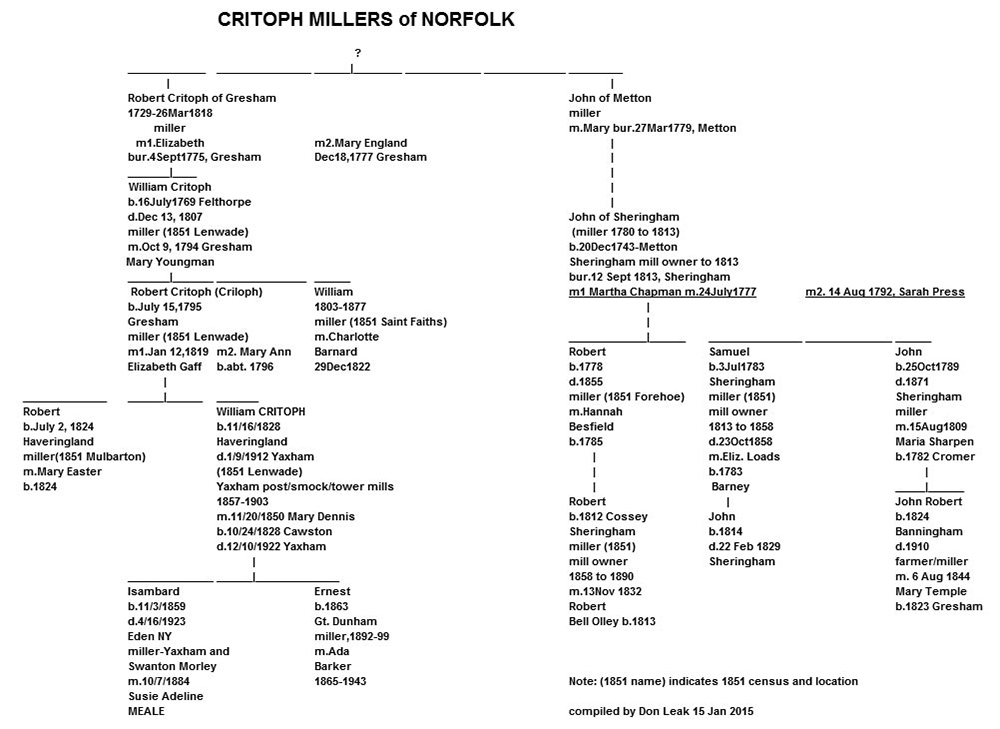 |
Mills include:- Gresham watermill, windmill, Gt Dunham, Mattishall, Sheringham, Swanton Morley, Upper Sheringham, Yaxham postmill, smockmill, towermill |
I have just looked at your website after seeing the photo of the mill in the Dereham Times which was submitted by your society. I was particularly interested as the man in the doorway is my grandfather Ernest Hilton. On the 18th September, in the report in the Times of the closure of the Mill Bakery it was stated that the distinctive black round building used as a store is to be demolished when the site is developed for housing. As you know, this round black "store" is the base of the original mill, and I have written to the paper hoping they will print my letter and attaching the photo of the mill showing this. I can't believe they will be allowed to demolish the mill base. Do you have any influence to prevent this happening? Your web site is excellent and I'm looking forward to finding out more about the mill and Elsing Mill, where my grandfather was a tenant for 9 years, the only time he was away from Swanton Morley. |
I remember the rounds man from the bakery was a Mr Price in the 1930s he
had a horse and cart and would come to the door with the bread in a
basket with a sack over the top, there were 2 types, large or small. He was
still around mid 1940s because one of my school mates ran into the cart
on his motor bike .. |
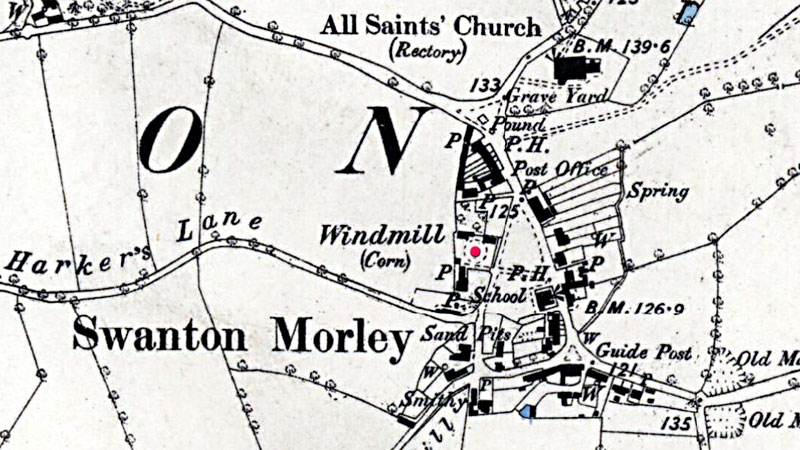 |
O. S. Map 1881 |
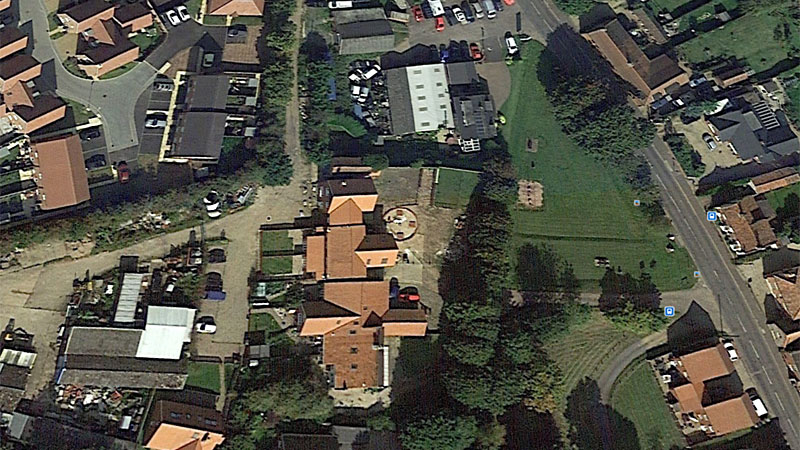 |
Roundhouse outline and pier positions - 24th September 2017 |
Kelly's 1908: Mrs. Emma Hilton, miller (steam), baker & farmer |
Index of Wills 1670: John Roote snr., miller
White's 1845: Francis Daynes, miller & baker
1853: John Williams, miller 1906: Mill buck demolished by Joseph Canham assisted by Albert S. Rump
1950: Mill House sold by Emma Hilton, widow of William Hilton |
If you have any memories, anecdotes or photos please let us know and we may be able to use them to update the site. By all means telephone 07836 675369 or
|
| Nat Grid Ref TG01861719 |
Copyright © Jonathan Neville 2004 |